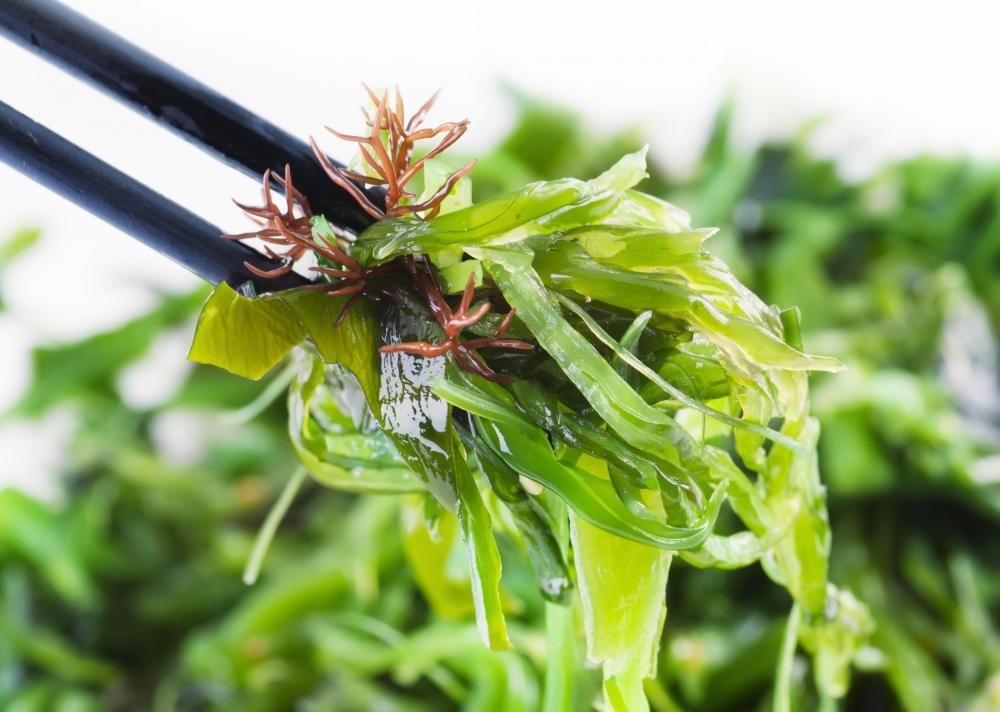At DelightedCooking, we're committed to delivering accurate, trustworthy information. Our expert-authored content is rigorously fact-checked and sourced from credible authorities. Discover how we uphold the highest standards in providing you with reliable knowledge.
What is Kombu?
Kombu is a Japanese word that describes most any edible kelp from the Laminaria family, though it is most commonly associated with the Laminaria japonica species. This type of kelp grows prolifically in the waters off the coast of East Asia, including not only Japan but also the Korean peninsula and parts of China, and its popularity has led to extensive commercial cultivation in these countries. Most of the kombu sold in stores comes from kelp farms, and is usually available fresh, frozen, dried, or pickled. It is used to flavor a range of dishes, but is perhaps most commonly associated with the Japanese dashi broth.
Flavor and Popularity

Asian cultures have been harvesting and eating kombu for centuries. The kelp’s salty, savory taste is often used as an illustration of umami, the “fifth sense” described by traditional Japanese cooks. Umami is frequently described as a “pleasant savoriness” that is distinct from the four standard taste sensations of sweet, salty, sour, and bitter.
The kelp is commonly eaten raw, often shredded into seaweed salads or used as an accompaniment to rice and meat dishes. Cooks often find that its rich salty flavor grows more concentrated through drying, though, and dried kelp strips are staples in many East Asian kitchens. Cooks commonly add a few flakes to boiling rice or cooking meat dishes to quickly and easily boost flavor. Some recipes call for the seaweed to remain in the dish once cooking is done, but it is usually removed, much as a bay leaf might be in more European-style cooking.

Food scholars often speculate that kombu is so popular across so many cultures because of how economical it is. The kelp grows naturally in shallow waters, harvesting it is often relatively simple, and nearly all parts of the plant are edible. It is a valuable source of nutrition on its own, and can add flavor to otherwise plain meals without the expense of more refined spices or herbs. Many traditional meals in Japan, China and Korea make liberal use of this sort of kelp, which has in many ways led to the rise of farms and harvest centers in coastal communities.
Fresh and Frozen Kelp

People who live in the sea vegetable’s natural growing region can often buy it fresh. It can be eaten straight from the sea, though most cooks will take care to prepare it at least somewhat before serving — it is often sliced, marinated, and often cooked before eating. Steaming and pan-frying are the most popular cooking methods, though some recipes call for grilling or baking. It can be eaten raw, though many complain that the plant has a certain toughness to it that is softened with heat.

Many kelp growers flash-freeze the plant in order to prolong its shelf life. It is usually at its peak within a few days of harvesting; freezing makes it easier to transport over long distances, and also gives cooks the flexibility to have it on hand on an almost perpetual basis. Frozen kombu often has a slightly different flavor from its fresh counterparts, but recipes can typically use the two interchangeably.
Dried Varieties

Dehydrating the kelp is another way to prolong its life and usefulness, though dried versions have a different set of taste properties — they are typically much saltier, and have a more concentrated flavor. As a result, cooks often use only a few flakes or strips to substitute for much larger quantities of fresh kelp.
There are a number of recipes that work best with dried versions, and many Asian cooks will keep flakes or strips on hand as a sort of essential seasoning or spice. Dashi, a popular Japanese soup base, is one example of a food that requires dried kombu. Dashi is made by boiling the kelp with fermented bonito flakes, and is an essential ingredient for such things as miso soup. Sushi chefs usually also add a dash of dried kelp to the sticky rice used in many rolls.

Many cooks will rinse or briefly soak dried strips before using them to remove the powdery white "film" that tends to form during drying. This film is created by starches that evaporate out of the kelp, and is generally understood to be harmless; it can impact the overall consistency or clarity of certain dishes, however, particularly broths. Removing it is common practice, but is at the discretion of the cook.
Picked Preparations

Cooks in many places pickle the seaweed, as well. Relishes require this sort of treatment, and typically feature other ingredients like peppers or bitter fruits. These are often served alongside meat or seafood dishes as a sauce or flavor enhancer. Many bars and traditional tea houses also offer bowls of pickled kelp to their guests; chunks can be served on their own, or over rice as snack between meals.
Shelf Life and Storage
While fresh seaweed must usually be eaten within a few days of purchasing or harvesting it, the same is not usually true for dried and pickled versions. Relishes and preserves are usually good for several years if unopened, and up to about two weeks in most cases once exposed to air. Dried strips and flakes are usually good almost indefinitely, though their flavor is usually best within about a year of dehydration.
Nutritional Information
Kelp in the Laminaria family is widely regarded as something of a nutritional powerhouse, as it is high in calcium, iron, iodine and dietary fiber while containing very few calories and no fat at all. Many experts credit it with relieving hypertension, and it can also be used to lower cholesterol. Dried versions do tend to have high levels of salt, but on the whole this sort of kelp is generally seen to be quite beneficial.
Important Precautions
Most people have no trouble eating or digesting sea vegetables like kelp, though foods in this category can interact badly with certain prescription drugs. Those who take medications high in potassium, as might be prescribed for thyroid dysfunction, are usually advised to talk to a medical professional before making kombu a regular part of their diet.
Use as an Alternative Fuel
Scientists in some places have evaluated kombu and related kelp as an alternative energy source, in part because of how easy it is to grow and how quickly it matures and regenerates. When combined with Escherichia coli bacteria, the kelp produces ethanol, which is used around the world to augment gasoline and other fossil fuels.
AS FEATURED ON:
AS FEATURED ON:

















Discussion Comments
The white powder is flavor, mostly a form of natural msg. Do not remove it. You'll be removing much of the flavor of the kombu. Ask any Japanese chef. They'll scream if they see you wipe the white stuff off.
There are other species of Laminaria that can be gathered in europe and are edible, like L. digitata, L. hyperborea, L. caccharina and many more edible seaweeds.
Personally I've never wiped the kombu off but I've only made dashi with it. The ichiban dashi(first dashi) has a nice flavor that isn't to fishy or strong(and makes a nice miso soup). The niban dashi(second dashi) just tastes kind of like funny tasting water, just barely a hint of flavor -- not enough to recognize and I've used it for making katsudon. I think it doesn't matter much if you wipe it or not.
The white "film" is starch. I don't know why, but every time I see a reference to using kombu, it mentions giving it a rinse or a moist wipe.
You're not actually removing much of the starch (because you wouldn't want to wash kombu either), but it seems to be standard practice. Maybe the rinse is just enough to keep you from overdoing the kombu flavor, because that starch has a lot of the flavor.
If the white film that develops is desired, why would you wipe it off with a damp cloth then? Or does the white film actually change the flavor just by growing, more like a matter of the seaweed aging instead?
Post your comments